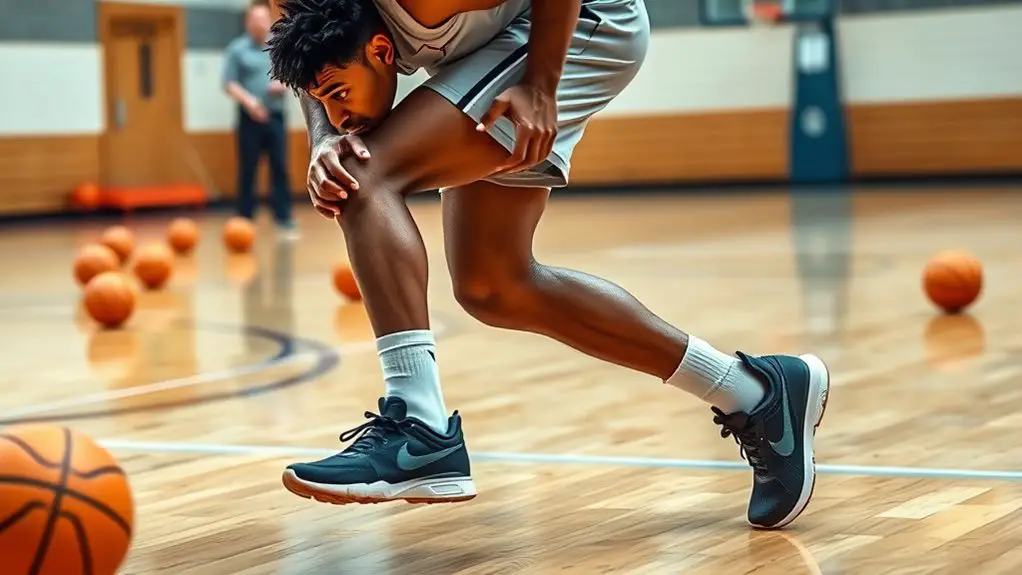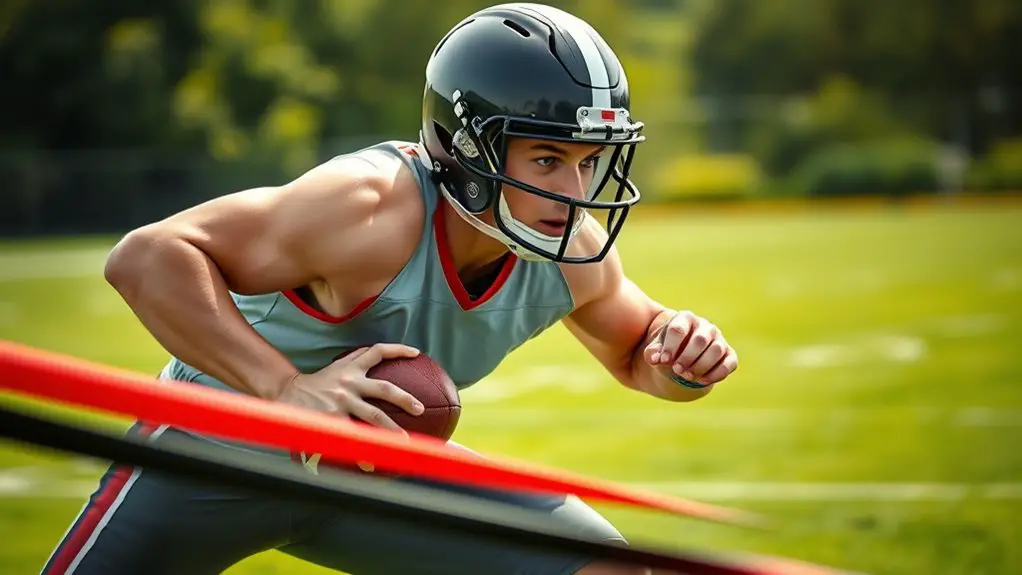To improve your outfield tracking skills, focus on understanding the physics of fly balls and how wind affects their trajectory. Enhance your eye coordination and practice depth perception to better gauge distance and angles. Develop a solid stance and master your footwork with drills like backpedaling and cone weaving. Finally, build confidence under pressure by simulating game scenarios and managing stress. Keep practicing, and you'll discover more techniques to elevate your game.
Understanding the Physics of Fly Balls
When you step onto the field, understanding the physics of fly balls can give you a significant edge. The way a ball travels through the air isn't random; it's shaped by ball physics. Knowing the forces at play, like gravity and air resistance, helps you predict where the ball will land. By analyzing the trajectory, you can position yourself more effectively, increasing your chances of making that catch.
Start by observing how the ball's angle affects its flight. A higher launch angle often results in a longer distance traveled, while a lower angle may lead to quick grounders. Use trajectory analysis to determine how wind conditions or spin can alter its path. This knowledge empowers you to make smarter moves, giving you the freedom to react confidently. Additionally, incorporating explosive power training into your routine can enhance your speed and agility on the field. Embrace the science behind the game, and you'll find yourself tracking fly balls with newfound precision and ease.
The Importance of Eye Coordination
Eye coordination is essential for tracking fly balls effectively. By honing your visual perception techniques and engaging in hand-eye synchronization drills, you'll enhance your ability to react quickly. Focus and concentration exercises can further sharpen your skills, ensuring you're always ready for that next catch. Incorporating reaction time drills into your training routine can significantly improve your overall performance in the field.
Visual Perception Techniques
Although many players overlook it, honing your visual perception skills is essential for effective outfield tracking. Your ability to pick up visual cues can make a world of difference when you're chasing a fly ball. Start by practicing your depth perception; this helps you gauge how far the ball is from you and the angle it's coming at. Try focusing on the ball's trajectory and adjusting your position accordingly. You can also enhance your awareness by observing how other players react to balls in the air. The more you train your eyes to recognize patterns and predict movement, the better you'll become. Embrace this aspect of your game, and you'll find yourself making those vital catches more regularly.
Hand-Eye Synchronization Drills
To improve your outfield tracking skills, mastering hand-eye synchronization is essential, as it directly impacts your ability to catch fly balls. Here are some dynamic drills to enhance your visual tracking:
- Tennis Ball Toss: Have a partner toss tennis balls at varying heights and angles. Focus on catching them with both hands.
- Reaction Ball Drills: Use a reaction ball to improve hand speed and reaction time. Catch it as it bounces unpredictably.
- Moving Targets: Set up targets that move side to side. Track and catch them while keeping your eyes locked in.
- Shadowing: Pair up and mimic each other's movements in real-time. This builds coordination and responsiveness.
Implement these drills regularly, and you'll see significant improvement in your tracking skills!
Focus and Concentration Exercises
Improving your outfield tracking skills goes beyond just hand-eye synchronization; it also involves honing your focus and concentration. To elevate your game, try incorporating mindfulness techniques into your routine. Simple practices like deep breathing or visualization can sharpen your awareness on the field.
Additionally, distraction management is essential. Identify what pulls your attention away during practice or games, and develop strategies to minimize these interruptions. For instance, setting specific goals for each practice session can keep your mind engaged.
Developing a Solid Stance
A solid stance is essential for outfielders, as it sets the foundation for effective tracking and catching of fly balls. To develop your stance mechanics and improve body alignment, consider these four key elements:
- Feet Position: Keep your feet shoulder-width apart for balance. You want to feel grounded yet ready to move.
- Knees Slightly Bent: This helps with agility and quick reactions. A relaxed posture lets you spring into action.
- Upper Body Lean: Lean slightly forward, keeping your chest over your knees. This stance keeps you engaged and focused.
- Hands Ready: Position your hands slightly away from your body, ready to react. Avoid crossing them or letting them hang.
Additionally, a strong core provides enhanced stability and control, which are crucial for maintaining your stance during dynamic movements in the outfield.
Mastering the Drop Step
Mastering the drop step is essential for enhancing your outfield tracking skills. It's all about quick reactions and proper foot placement to get you moving in the right direction. With the right drills, you can practice and refine this technique effectively.
Importance of Quick Reaction
Quick reactions can make all the difference in outfield play, and mastering the drop step is essential for any player looking to enhance their tracking skills. Improving your reaction time and quick reflexes can help you get to the ball faster and make game-changing plays. Here are a few tips to elevate your skills:
- Practice drills that focus on your reaction speed.
- Visualize different game scenarios to prepare your mind.
- Stay relaxed and confident; tension slows you down.
- Use agility exercises to enhance your footwork and speed.
Proper Foot Placement Techniques
Understanding proper foot placement techniques is essential for executing an effective drop step. When you're tracking a fly ball, your foot placement directly impacts your balance and speed. To master this skill, focus on your angle and direction during the drop step. Here's a quick reference table to guide you:
| Foot Position | Purpose | Balance Techniques |
|---|---|---|
| Back foot planted | Create a stable base | Shift weight smoothly |
| Front foot angled | Direct movement | Keep knees slightly bent |
| Weight centered | Maintain stability | Engage core for support |
Drills for Effective Practice
As you work on improving your drop step, incorporating specific drills into your practice routine can make a significant difference. Mastering this technique will enhance your catching skills and overall tracking abilities. Here are four effective drills to try:
- Backpedaling Drill: Start by backpedaling to track a fly ball while focusing on your foot placement.
- Cone Drill: Set up cones to simulate different angles, practicing your drop step and acceleration.
- Partner Throws: Have a partner throw balls at varying distances, forcing you to react quickly and apply catching techniques.
- Mirror Drill: Use a mirror to analyze your drop step mechanics, ensuring you maintain proper form during tracking drills.
Integrating these drills will boost your confidence and performance in the outfield!
Practicing Your Footwork
Mastering your footwork is essential for improving your outfield tracking skills. Proper foot placement and agility drills can make all the difference in how quickly you react to the ball. Here's a simple table to guide your practice:
| Drill Type | Focus Area | Duration |
|---|---|---|
| Ladder Drills | Agility & Speed | 10 minutes |
| Cone Weaving | Quick Footwork | 15 minutes |
| Side Shuffles | Lateral Movement | 10 minutes |
| Backpedaling | Tracking Depth | 10 minutes |
Improving your footwork not only enhances your tracking skills but also contributes to better injury prevention through proper foot placement and balance.
Using Drills to Enhance Tracking Skills
Once you've honed your footwork, it's time to focus on drills that specifically target tracking skills. Enhancing your ability to follow the ball is essential, and engaging in targeted catching drills can make a real difference. Here are four effective drills to try:
- Ball Toss Drill: Have a partner toss the ball at varying heights and angles. Practice tracking the ball's movement with your eyes and body.
- Shadowing Drill: Stand in an open field while a partner throws the ball. Move in sync with the ball's trajectory, mimicking the movement without catching it.
- Cone Drill: Set up cones to create a zigzag pattern. As a partner throws balls at different angles, sprint to each cone, focusing on tracking the ball.
- Reaction Drill: Set a timer and have a partner call out random directions. Track and catch the ball as quickly as you can.
Incorporating agility ladder drills into your training routine can also significantly enhance your overall agility and coordination, which are critical for tracking skills. These tracking techniques will help you become a more agile and aware outfielder.
Anticipating the Ball's Trajectory
To effectively track a fly ball, you need to anticipate its trajectory, which can greatly enhance your performance in the outfield. Start by practicing trajectory prediction; pay attention to the ball flight and assess the angle it leaves the bat. Environmental factors like wind can alter its path, so stay aware. Positioning yourself correctly based on these assessments is vital. Utilize mental visualization to picture the ball's route, which sharpens your spatial awareness. This not only aids in trajectory forecasting but also heightens your reaction timing. Trust your instincts—developing instinctive judgment will help you respond quickly. Focus on where the ball is likely to land and adjust your positioning accordingly. Additionally, good balance enhances your coordination and reaction to the ball's movements. By honing these skills, you'll improve your overall ability to track fly balls and become a more effective outfielder, embracing the freedom that comes with confident, decisive movements on the field.
Learning to Read the Wind
Understanding how to read the wind can greatly enhance your ability to track fly balls in the outfield. When you grasp wind patterns and how they interact with weather conditions, you'll become a more effective player. Here are some tips to help you learn to read the wind:
- Observe Pre-Game: Check the direction and intensity of the wind before the game starts.
- Watch the Flags: Notice how flags are positioned around the field; they can indicate wind direction.
- Feel the Breeze: Pay attention to how the wind feels on your face—this can guide your positioning.
- Practice with Different Conditions: Spend time practicing during various weather conditions to understand how the wind affects ball flight.
Building Confidence Under Pressure
Building confidence under pressure is vital for any outfielder, especially when the game is on the line. To tackle performance anxiety, start by incorporating pressure simulation into your practice routine. Create scenarios that mimic high-stakes situations, allowing you to build mental resilience. Use visualization techniques to picture yourself making the play successfully; this mental rehearsal can enhance your confidence.
Pair this with stress management strategies, like deep breathing exercises, to stay calm when it counts. Positive self-talk is important—remind yourself of your skills and past successes. Acknowledge your feelings, but don't let them overwhelm you; instead, develop coping strategies that help you refocus. Additionally, understanding the sources of stress in elite sports can help you better navigate mental strain and anxiety during critical moments.
Ultimately, the more you practice these techniques, the more confidence you'll build, transforming pressure into an opportunity for greatness. Embrace the challenge, and let your abilities shine when it matters most!
Analyzing Game Situations for Improvement
While you may focus on perfecting your physical skills, analyzing game situations can greatly enhance your outfield tracking abilities. By developing your situational awareness, you'll make smarter decisions on the field. Here are four key game scenarios to examine:
- Batter's tendencies: Know who's at bat and their hitting patterns. This helps predict where the ball might go.
- Game context: Understand the score, inning, and outs to gauge the importance of each play.
- Field conditions: Pay attention to wind, sunlight, or field wetness, as these factors can affect ball trajectory.
- Teammate positioning: Be aware of where your teammates are. Communication can prevent collisions and enhance coverage.
Frequently Asked Questions
What Equipment Can Help Improve Outfield Tracking Skills?
You'd think fancy tracking aids and training tools would make you a pro overnight, right? Well, not quite. But they can definitely make the journey more enjoyable. Try using a radar gun to measure your speed or a ball tracker to enhance your reaction time. You might even find a training app that turns practice into a game. With the right gear, you'll feel that sense of freedom on the field, tracking like a champ!
How Can I Practice Tracking Skills Alone?
Practicing tracking skills alone can be really rewarding. You can set up solo drills, like tossing a ball against a wall and catching it as it rebounds. Incorporate visualization techniques by imagining game scenarios while you practice, which helps sharpen your focus. You'll feel a sense of freedom as you create your own drills, allowing you to work on your timing and positioning without needing a partner. Enjoy the process and watch your skills improve!
Are There Specific Drills for Different Field Positions?
When you're looking to enhance your skills, it's essential to focus on position-specific drills. Each position has unique tracking techniques that can help you excel. For instance, outfielders might practice catching fly balls while tracking the ball's trajectory, while infielders could work on reacting to grounders quickly. Tailoring your drills to your position allows you to develop the freedom to move confidently and instinctively during games, improving overall performance on the field.
What Mental Techniques Can Enhance Tracking Performance?
To enhance your tracking performance, consider using visualization techniques. Picture the ball's trajectory and your movement in real-time; it can sharpen your instincts. Focus exercises, like narrowing your attention to the ball while blocking out distractions, can also help you stay present in the moment. Embrace these mental strategies, and you'll find yourself more aware and ready to react, giving you the freedom to play your best game without hesitation.
How Can I Recover From Tracking Errors During Games?
You might think tracking errors are the end of the world, but they're just bumps in the road. To recover during games, focus on your breathing to regain calmness. Visualize the ball's path to re-establish your focus. Use recovery techniques like adjusting your position quickly and staying aware of your surroundings. Remember, every player makes mistakes; it's how you bounce back that defines you. Embrace the challenge and keep playing with confidence!



